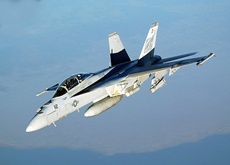Boeing, considered the frontrunner in the race to supply the Indian Navy with new fighter jets, is now in contention for a much bigger $15-billion order after the government abruptly asked the Indian Air Force to consider Boeing’s the twin-engine planes, Reuters reported.
 |
|
| Boeing’s twin-engine F/A-18 Super Hornet |
|
Until recently, Lockheed Martin Corp’s F-16 and Saab AB’s Gripen were the only manufacturers in the fray to supply at least 100 single-engine jets to build up the IAF’s rapidly-depleting combat fleet. Both had offered to build the planes in India in collaboration with local companies under the‘Make in India’ programme to build a domestic industrial base and cut back on arms imports.
But last month the government asked the IAF to open up the competition to twin-engine aircraft and to evaluate Boeing’s F/A-18 Super Hornet, a defence ministry source told Reuters. That jet is a finalist for the Indian Navy’s $8 - $9 billion contract for 57 fighters.
In the next few weeks, the defence ministry plans to issue a request for information (RFI), the first stage of a procurement process, for a fighter to be built in India. The competition will be open to both single and twin-engine jets, the official said, but both Lockheed and Saab said they had not been informed about the new criteria.
The latest change of stance is a major opportunity for Boeing, whose only foreign Super Hornet customer so far is the Royal Australian Air Force.
Though the need for new fighters has been known for nearly 15 years, but after many announcements and about turns, the IAF has only three-quarters of the aircraft it needs.
An indigenous light combat aircraft, the Tejas, is still not operational 35 years after it was first proposed.
An Indian Air Force source said fighter procurement was urgent — the branch’s operational strength has fallen to just 33 squadrons, its weakest level in four decades, as it decommissions Soviet-era MiG-21s.
“The IAF wants the RFI issued within weeks and get the process started,” said the source, who declined to be identified because he was not authorised to speak to the media, Reuters reported. “The problem is that government keeps shifting what it wants.”
Over the next decade, 13 more squadrons will be retired as aircraft age out of service, parliament’s standing committee on defence said in a December report.
The defence ministry declined to comment on the air force’s aircraft modernization programme.
Lockheed, which had offered to shift its F-16 production line from the US to India, said it had not been told of any change to the Indian plan for single-engine fighters. “Our proposed F-16 partnership with India stands firm,” the company said in an email.
Last year it picked Tata Advanced Systems as its local partner and said it was in talks with dozens of firms to build up the supplier network.
“The government of India has not yet issued formal requirements but we are continuing to support government-to-government discussions and engage with Indian companies about F-16 industrial opportunities,” Lockheed said.
Sweden’s Saab was also caught off guard.
“We have seen the reports in the Indian media, but no new formal communication has been made to us regarding the fighter program,” said Rob Hewson, Saab Asia Pacific’s head of communications.
France’s Dassault Systemes SE’s Rafale, the Eurofighter Typhoon and Russian aircraft are also potential contenders under the new requirements, the air force source and industry analysts said.
Admiral Harry Harris, the head of US Pacific Command, told the U.S. House Armed Services Committee last month that India was considering the F-35 stealth fighters, among other options. But the Indian Air Force said no request had been made to Lockheed for even a briefing on the aircraft.
The Indian air force competition has echoes of a 2007 tender for 126 medium multi-role combat aircraft, for which Dassault was selected for exclusive negotiations. But the talks quickly bogged down over local production and prices, and in the end, the government ordered just 36 Rafales in 2016 for $8.7 billion.
The air force ideally would like a combination of lighter single-engine and twin-engine jets, as well as stealth aircraft, but cannot afford such a range of foreign systems, analysts said.
A twin-engine foreign fighter would perhaps offer the best value while the Tejas finishes development, they said.
India’s annual defence capital procurement budget of $14 billion to $15 billion has to be spread over the Army, Navy, Air Force and the indigenous defence research organization DRDO.
“The operational costs are going up with increased manpower, higher wages and general inflation. The ministry of defence doesn’t have the luxury to go for too many platforms despite the rapidly falling squadron strength of the Air Force,” said Amber Dubey, partner and India head of aerospace and defence at global consultancy KPMG.
Boeing India President Pratyush Kumar said the company was ready to respond to any request from the Air Force, and said it had offered to help with India’s plans to develop its own advanced medium combat aircraft.






















